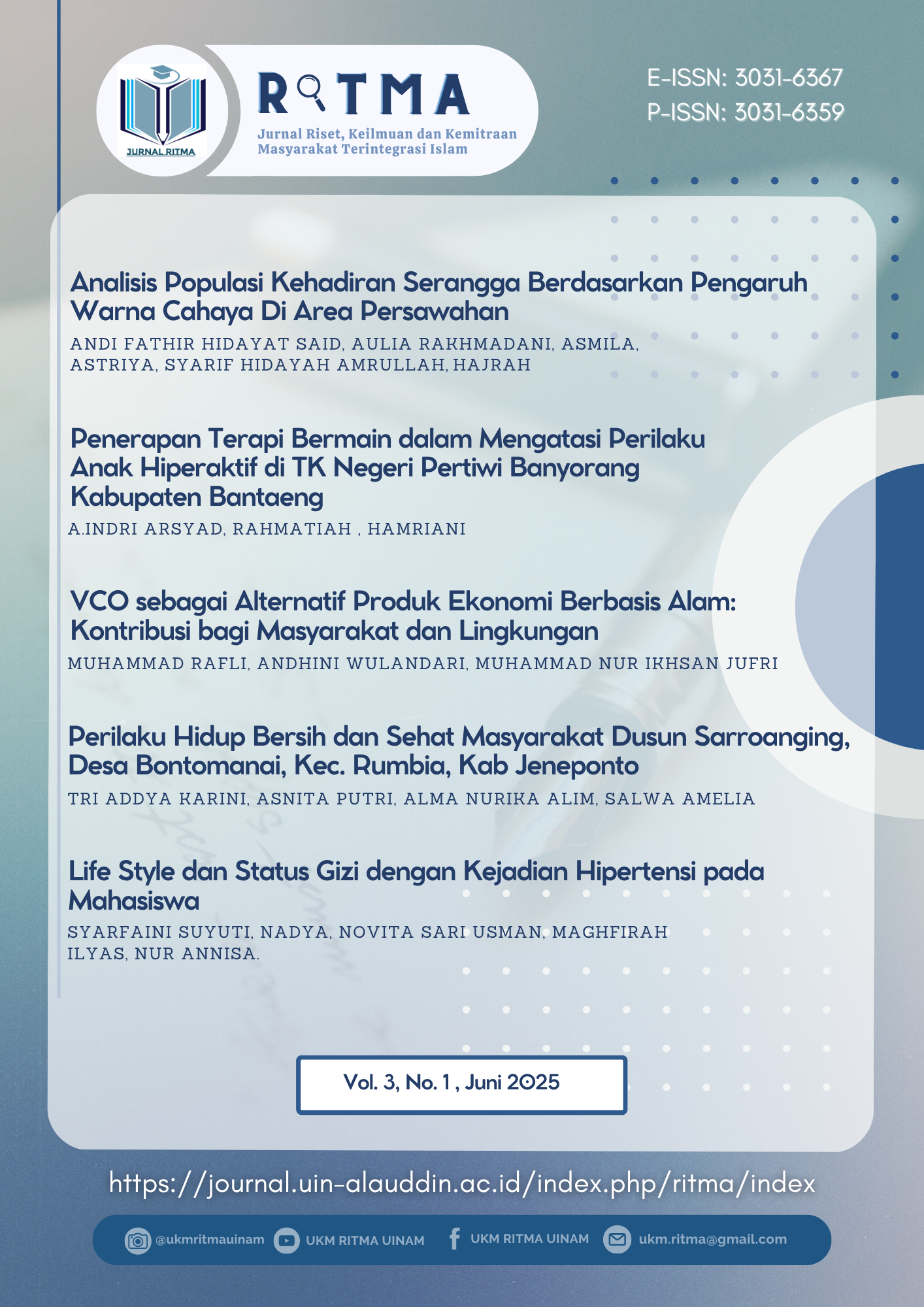Analisis Populasi Kehadiran Serangga Berdasarkan Pengaruh Warna Cahaya Di Area Persawahan
Keywords:
Light Trap, Perilaku, Sawah, Serangga, NocturnalAbstract
Insects are highly adaptive and diverse invertebrates. Insects are very sensitive to light, especially nocturnal insects. Nocturnal insects are active at night and do many things, such as searching for food, reproducing, and helping to maintain low temperatures. During the day, these insects are unable to do many activities. The purpose of this study was to determine how the color of light affects the presence of insects in rice fields at night. This study used a field experiment method with an experimental design involving three different types of light traps (yellow, blue, and white). Each type of light was tested with three replications of direct observation in the field (rice fields) that had been planted with rice using a light trap. The results showed that the yellow light trap caught the least amount. This shows that the color of light affects the number of nocturnal insects attracted, not the intensity of the light.
References
Aditama, R. C., & Kurniawan, N. (2013). Struktur Komunitas Serangga Nokturnal Areal Pertanian Padi Organik pada Musim. Jurnal Biotropika, 1(4), 186.
Faradila, A., Nukmal, N., & Dania Pratami dan Tugiyono. (2020). Keberadaan Serangga Malam Berdasarkan Efek Warna Lampu Di Kebun Raya Liwa. Bioma: Berkala Ilmiah Biologi, 22(2), 130–135.
Fatmala, L., Kamal, S., & Agustina, E. (2017). Keanekaragaman Arthropoda Permukaan Tanah Di Bawah Tegakan Vegetasi Pinus (Pinus merkusii) Tahura Pocut Meurah Intan. Program Studi Pendidikan Biologi Faklutas Tarbiyah Dan Keguruan UIN Ar Rainry, 8(1), 166–171.
Hakim, L., Surya, E., & Muis, A. (2017). Pengendalian Alternatif Hama Serangga Sayuran dengan Menggunakan Warna sebagai Perangkap Mekanis. Serambi Saintia, V(1), 33–44.
Hanan, A. F., Pratikto, I., & Soenardjo, N. (2020). Analisa Distribusi Spasial Vegetasi Mangrove di Desa Pantai Mekar Kecamatan Muara Gembong. Journal of Marine Research, 9(3), 271–280. https://doi.org/10.14710/jmr.v9i3.2757 3
Herlinda, S., Pujiastuti, Y., Irsan, C., Karenina, T., Budiarti, L., Rizkie, L., & Octavia, M. (2021). Pengantar Ekologi Serangga Published.
Humberg, T. H., & Sprecher, S. G. (2017). Age- and Wavelength-Dependency of Drosophila Larval Phototaxis and Behavioral Responses to Natural Lighting Conditions. Frontiers in behavioral neuroscience, 11, 66. https://doi.org/10.3389/fnbeh.2017.00066
Ilham, A. (2015). Keanekaragaman Jenis Serangga Nocturnal Pada Perkebunan Kelapa Sawit Kecamatan Besulutu kabupaten Konawe Sulawesi Tenggara. Universitas Halu Oleo.
Irni, J. (2021). Inventarisasi Serangga Malam (Nocturnal) Pada Lahan Konversi Teh Menjadi Kelapa Sawit. Agroprimatech, 5(1), 37–43. https://doi.org/10.34012/agroprimatech .v5i1.2084
Nirmal, Akash., Gajbhiye1, Rupesh. Kumar., Sidar, Yogesh. Kumar., Ganguli, Jaya, Laxmi. (2017). Evaluation of Light Trap against Different Coloured Electric Bulbs for Trapping Phototrophic Insects. Int.J.Curr.Microbiol.App.Sci. 6 (6). 2068-2073.
Paryavi, M., Weiser, K., Melzer, M., Crook, D., Ramadugu, C., & Jenkins, D. M. (2025). Programmable LED Array for Evaluating Artificial Light Sources to Improve Insect Trapping. Insects, 16(2), 170. https://doi.org/10.3390/insects16020170
Rachmasari, O. D., Prihanta, W., & Susetyarini, R. E. (2016). Keanekaragaman Serangga Permukaan Tanah di Arboretum Sumber Brantas Batu-Malang Sebagai Dasar Pembuatan Sumber Belajar Flipchart. Jurnal Pendidikan Biologi Indonesia, 2(2), 188–197.
Rosalina, E., Nadya, Mustari, M., Rahmi, G., & Hanim, N. (2022). Pengaruh Warna Lampu Terhadap Kehadiran Serangga Nokturnal Di Kawasan Pesisir Lut Tawar Kabupaten Aceh Tengah. Prosiding Seminar Nasional Biotik 2022, 10(2), 222–227.
Rusyana, A. (2011). Zoologi Invertebrata. Alfabeta.
Santi, Idum Satia., Firmansyah, Erick., Febrian, Bayu Muhlin., Listianto, Herry. (2023). The Effectiveness of Trap Colors Against the Catch of Rice Plant Pests. Tropical Plantation Journal. 2 (1), 28-33. https://doi.org/10.56125/tpj.v2i1.17


